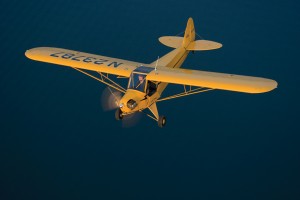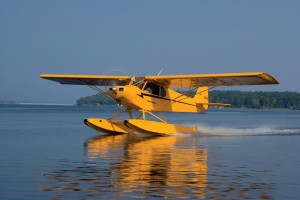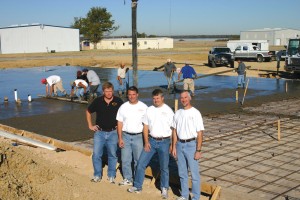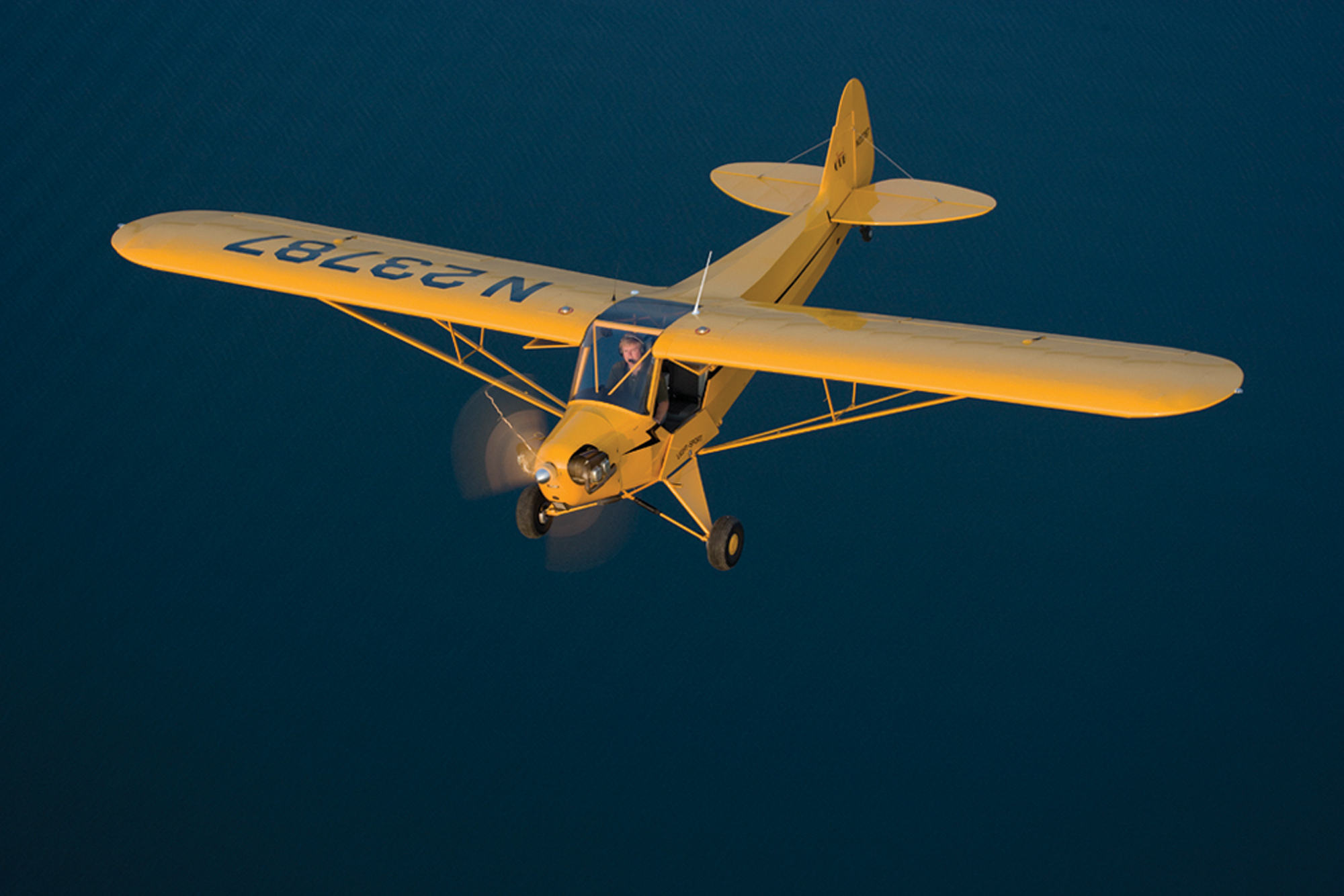By S. Clayton Moore
Talk about American know-how. Two entrepreneurs from Sulphur Springs, Texas, have managed to resurrect an aviation classic with their Legend Cub, a new version of the timeless Piper J-3 Cub. In less than a year, the American Legend Aircraft Company has built, certified and delivered the airplanes to 15 customers and plans to expand their production capacity this year.

The striking yellow and black paint of the new Legend Cub recalls its predecessor, the famous Piper J-3 Cub.
Designed to appeal to recreational fliers, retro enthusiasts and light sport plane pilots, the Legend Cub is a unique offering among new aircraft. The two-place, single-engine aircraft offers both the enjoyment of a sport aircraft and the economy of a light design.
It started at EAA AirVenture Oshkosh two years ago, when Legend’s two founders came looking for a Super Cub kit on which to mount some floats. Tim Elliot is the CEO of Access E-Forms, a healthcare software company. He came to the show with Darin Hart, the owner of Alpha Omega Jet Services, which specializes in building corporate interiors for business jets.
“We went to buy this Super Cub and the place we were negotiating with said it would be 18 months before we could get our hands on a kit,” said Elliot. “That was just too long to wait. Darin turned to me and said, ‘You know what? We can just build our own.'”
It was an ambitious plan with a remarkable coincidence in timing. The very next day, the Federal Aviation Administration announced the finalization of the sport pilot/light-sport aircraft rule, which created an entirely new market for the new American Legend Aircraft Company to tap, and a new certification under which to operate their aircraft.
The rule simplifies the regulations and requirements for sport pilots, limiting them to certain certifications of aircraft, but also requiring only a driver’s license, instead of a full medical. The rule gives an option to many pilots and would-be pilots who shy away from flying because of the cost, time investment or medical requirements.
“It really is designed for sport flying,” Elliot observed. “It gives guys, who were regular pilots at one time, an option to be sport pilots and fly again.”
Darin Hart had already rebuilt several Cubs and won an award at Oshkosh with a rebuilt J-3 Piper, so the base knowledge behind the company was sound. Elliot and Hart began a comprehensive design study and used SolidWorks, 3D modeling software, for mechanical design. They started constructing their first prototype in February 2005.
Another advantage was that the Legend Cub wasn’t required to go through extensive Part 23 certification. The new sport plane rule allowed them to build the plane and certify it under American Standards for Testing and Materials.
“Instead of having to jump through the same hoops as Beechcraft and Cessna, we were allowed to go through F37 ASTM certification,” Elliot explained. “It’s basically a mirror of Part 23. The difference is that the FAA doesn’t come in until you start the final certification process. It would have cost us $2 million to certify the airplane under Part 23, but it cost us only half a million this way. We were able to lower the price of the airplane, because we didn’t have to pass on those costs to our customers.”
Aficionados of the classic Piper design are amazed by the way the Legend Cub captures the spirit of the original. It comes, as Elliot laughingly explains, in any color you want, “as long as it’s yellow and black,” just like the original. Actually, the school bus yellow of the Legend Cub is slightly more vibrant than the original color, closer to what you see on a Stearman biplane.
“People ask if this is a replica or a look-alike,” Elliot said. “It’s more of a look-alike. People know the Piper Cub when they see one, and they like the way it looks, so we designed the look of the aircraft to be very close to the original. The lines of the aircraft are slightly different. The dimensions are similar, but they’re not the same.”
The modern Cub offers numerous enhancements, such as an electric starter and modern instrumentation. Legend’s aircraft is three inches wider than its forerunner, which makes it roomier on the inside than you would imagine. Taking into account the wider body, the designers chose a spring gear, which gives the aircraft more stability and makes it easier to land.
Elliot and Hart purposely overbuilt the aircraft above FAA standards for light aircraft. The Legend Cub will handle more stress than a typical aircraft at 1,430 pound gross weight.

The assembly of each Legend Cub starts with the choice of an open or closed cowl and whether or not the new owner wants the plane on floats.
“The fuselage is actually stronger than a Super Cub,” Elliot said. “In fact, it flies much more like a Super Cub than a J-3.”
It has a fuel capacity of 22 gallons and a range of about 315 miles. For safety, the fuel is held in two 11-galloon wing tanks, with no tank in the nose. Both its takeoff and landing distances are 350 feet, and the Legend Cub has a service ceiling of 15,000 feet.
New manufacturing techniques and materials have produced a final design with some unique characteristics. Legend’s CAD drawings are sent to a Canadian company, which sends back a complete set of numbered parts. These parts are then tack welded on a jig in Sulphur Springs. The final welding is done with the fuselage on a rotisserie.
“Every airframe comes off perfectly straight,” Elliot explained. “You wouldn’t think it would matter that much, but it really enhances how the airplane flies. Because the aircraft is so straight and the wings are perfect, it creates less drag. We also have three inches of dihedral on the wing, so once you get off the ground, you can literally fly the airplane with your feet on the floor. You can’t do that in the old Cub.”
The Legend Cub is powered by the reputable Teledyne-Continental 0-200, a four-cylinder, 100-horsepower engine that gives the aircraft a cruise speed of about 84 knots and a rate of climb of 500 feet per minute. It’s a healthy increase from Piper’s old 65-hp engine.
“It’s the smallest American-made horsepower engine you can buy,” Elliot said. “The only other options are the Rotax and the Jabiru, which are both good engines. We’ll be doing some testing this spring with the Jabiru 3300, but the Continental 0-200 is proven. Thousands of them are out there, flying on Cessna 150s. We were looking for the lowest-weight engine with the highest horsepower, so we felt that the Continental was the way to go.”
One of the most unique aspects of the Legend Cub dates back to its designers’ initial desire to put a Super Cub on floats. The assembly of each Legend Cub starts with the choice of an open cowl or a closed cowl and also whether or not the new owner wants the plane on floats.
“One of the tough things about seaplanes is that if you only have a door on one side, you either have to dock on that side or move across the front of the airplane,” Elliot explained. “Everyone who flies seaplanes has always said that the perfect seaplane would have doors on both sides, so that’s what we did.”
With standard steam gauges, the base aircraft starts at $74,000. American Legend can install a range of optional equipment, such as the Garmin 250XL navigational package, the Dynon D-100 flight information system, a BRS ballistic parachute or Baumann floats.
“Several guys have bought planes and gotten them up over $100,000,” Elliot confirmed. “The inside of the airplane is completely different than a classic Piper.”
The company has had several major accomplishments in the past year. Legend Aviation flew its prototype aircraft for the first time on March 11, 2005, during a celebratory public event at its home airport in Sulphur Springs. In order to debut the new Cub at Sun n’ Fun in April, the company quickly fabricated two flying prototypes, code-named Daphne and Tweety, and flew them from Texas to central Florida for their first cross-country flight. At the show, Elliot and Hart also secured orders for their first eight aircraft.
Marketing efforts continued as summer arrived, with the company participating in a nationwide tour to promote the newly created sport pilot rules. The Legend Cub made stops in Missouri, Pennsylvania and California, offering customers an up-close look at the rumored aircraft. Elliot and Hart also brought the aircraft to AOPA headquarters in Frederick, Md., and to the annual Sentimental Journey Fly-In at Lock Haven, Penn., where Cub enthusiasts commended the company for bringing back an aircraft near and dear to their hearts.

The assembly of each Legend Cub starts with the choice of an open or closed cowl and whether or not the new owner wants the plane on floats.
On July 21, 2005, American Legend was awarded type certification of its Legend Cub as a light-sport aircraft. On October 7, during a ceremonial handover at the Copper State Regional EAA Fly-in in Casa Grande, Ariz., Elliot and Hart delivered their third production Legend Cub.
Demand for the aircraft has been robust. The company has already delivered 15 aircraft and the Legend Cub is sold out through fall 2006. While Legend’s customer demographics are very diverse, they do share some characteristics.
“We’ve had all kinds of customers,” Elliot said. “A lot of the guys who buy the planes are over 50, and typically, they learned how to fly in a Piper Cub. Either out of necessity or in order to go to a light sport aircraft, they’ve decided to go with one of our airplanes. For a lot of them, this is their second aircraft to just go have fun in.”
Elliot admits that while a refurbished J-3 costs less than the Legend Cub, a factor for many buyers is the fact that Legend’s aircraft is brand new.
“If someone is on the fence, they need to look good and hard at the differences,” Elliot said. “You can buy a much refurbished J-3 Cub for $50,000, which is very cool. But if you want to be able to get in the plane, turn the key and start it, ours is the airplane. It still has all the reliability of everything we’ve learned since 1939.”
Demand has also driven the expansion of American Legend’s operations in Sulphur Springs. Its first production aircraft were built in a section of Hart’s company hangar. Future aircraft will be manufactured and assembled in a new facility that will house both aircraft production operations and a new customer delivery center.
American Legend is building a new 20,000-square-foot hangar for aircraft fabrication, assembly and R&D for future projects. An adjacent 5,000-square-foot hangar will house sales and marketing. The expansion doubles the company’s current capacity to 45,000 square feet.
“It gives us more of an assembly-line process,” Elliot said. “Right now, we have things in a lot of different buildings, so this will get us all under one roof. That should streamline things a lot.”
As the company finished its first year of operation, Elliot observed that the hard work behind the Legend Cub has a lot to do with its customers.
“The most important goal of American Legend was to keep our manufacturing and delivery promises,” he said. “We firmly believe that a promise made must be kept. The company has met, and in some cases, exceeded all customer commitments. We’re extremely pleased with the company as a whole and the progress that we’ve made.”
American Legend now employs about 40 staff and may slightly expand that number, but Elliot and Hart are still aiming to keep the cost of the airplanes down and efficiency up. By this fall, they also expect production to increase from its current four aircraft per month to eight.
The quick evolution of the Legend Cub is a remarkable achievement, but one that Elliot and Hart accomplished for the love of the airplane.
“All we wanted to do was to create an aircraft that is brand new but looks old,” Elliot said. “Everyone seems to like them, so we’re happy.”
For more information, call 903-885-7000, or visit [http://www.legend.aero].











